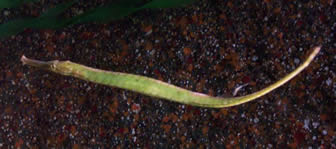Pipefish

There are roughly 200 known pipefish species in the world and they belong to the family Syngnathidae. This family is also where you will find the seahorses and the weedy and leafy sea dragons. All the species in the family Syngnathidae have a very special way of caring for their offspring. The females will deposit their eggs in a pouch that is located on the chest of the male. The male will then fertilize the eggs and incubate them until they hatch. In some species, the male has no pouch and the eggs are instead attached to him.
A vast majority of the different pipefish species is found in the ocean, but a few species live in freshwater instead. In tropical, sub-tropical and temperate zones you will usually find a broad array of pipefish along the coasts. They prefer to stay in sheltered environments, such as seagrass beds, lagoons and coral reefs.
A pipefish is small and look quite similar to the more famous seahorse, but its body is straight (the body of a seahorse ends in a curve). The body is long and thin, and this makes the pipefish somewhat snakelike. A pipefish is typically shorter than 20 centimetres. The pipefish derives its name from its specialised snout. The snout is pipe-like and the long tube ends in a very small and narrow opening that form the mouth of the pipefish. The mouth has no teeth and opens upwards.
The skeleton of the pipefish is highly specialized and have developed into armoured plating. In most fish species from other families and orders, a vertical section through the body would look round or oval. This is however not true for the needlefishes. Their skeleton is made up by several longitudinal ridges and they will therefore look angular rather than oval or round. The pipefish have minuscule gill-openings and you will find them close to the upper posterior angle of the gill-cover.
All pipefish species are equipped with a dorsal fin, and in many pipefish species this is the sole organ responsible for locomotion. This makes the pipefish a comparatively weak swimmer, especially in open waters. Even when it moves its dorsal fin very rapidly it will still only move forward in a gentle pace. The other fins commonly found on other fish species can be more or less developed, except for the ventral fins that never occur in pipefish species.
One of the pipefish species that is commonly kept in aquariums is the Alligator pipefish, Syngnathus biaculeatus/sp. This pipefish grow up to 12 inches long and has green or brownish body coloration. When you look at the head of the Alligator pipefish, you clearly see that this species is a relative of the seahorses. The Alligator pipefish is a very docile and peaceful aquarium inhabitant. You can usually feed your Alligator pipefish small ghost shrimp, brine shrimp or mysis. Some specimens can however refrain from eating anything but live mysis and must be provided with this; otherwise they will starve to death.
Just like many other pipefish species, the Alligator pipefish is not a strong swimmer and it seems to prefer to float in the current in the aquarium. Keeping several Alligator pipefish together in the same aquarium is a good idea, since you will be able to watch them as they form fascinating “pipefish-trains” by grabbing hold of each other and floating together in a long row. They can also preferably be housed together with seahorses, since these two organisms seem to have a special relationship. Seahorses enjoy grabbing the Alligator pipefish by the tale and hitch-hike. The pipefish do not seem to be disturbed by this; it will actually seek out seahorses in the aquarium.
Pipefish Articles
Banded pipefish - How to keep and care for the banded pipefish
